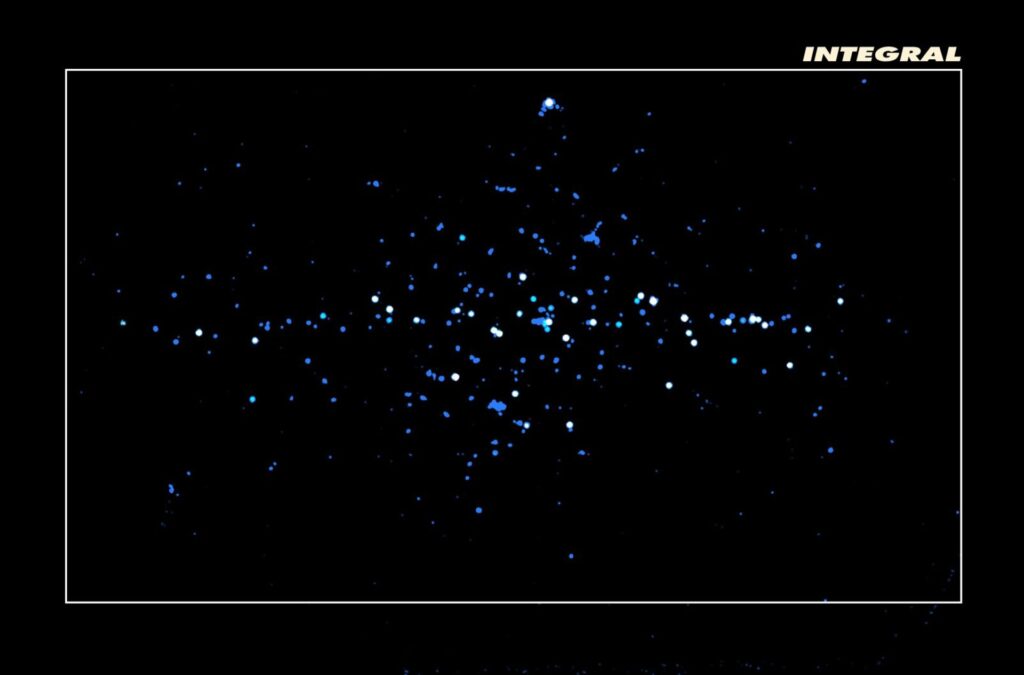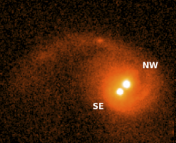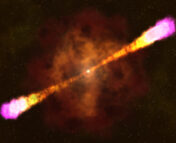
I’m Aafia Zainab, a PhD candidate at Dr. Karl Remeis Observatory in the picturesque town of Bamberg, Germany, affiliated with Friedrich Alexander University of Erlangen-Nuernberg. I mainly work on X-ray binaries in survey data, with the slightest soft spot for neutron stars. I spend the rest of my time baking cakes and playing board games, and occasionally writing about something I find important.
October 17th, 2022 marked the 20th birthday of INTEGRAL, the INTErnational Gamma-Ray Astrophysics Laboratory, which was celebrated in style at the INTEGRAL conference at ESA’s European Space Operations Centre in Darmstadt, Germany. The event was accompanied by a pervasive air of nostalgia for how it all started, a well-earned sense of accomplishment for everything this veteran telescope has made possible, but also melancholic uncertainty over its future, at all the things it could do if we would only allow it.

Black holes and neutron stars, long the subject of pop science enthusiasm, are notoriously difficult to find — when on their own. Thankfully, a large fraction of these compact objects exist in binary systems, where they feed off of their companion and emit radiation at high energies (X-rays and/or Gamma-rays). A section of these X-ray binary systems (XRBs) are called High Mass X-ray Binaries (HMXBs) due to the large masses (>10 M☉) of their companion stars. When it comes to searching for these exotic objects, INTEGRAL is the observatory for the job, equipped with two instruments — the Spectrometer SPI and Imager IBIS, and their supportive monitors that keep an eye each on interesting sources — X-ray monitor JEM-X and the Optical Monitoring Camera (OMC).
20 years and more than 600 new hard X-ray (with energies greater than about 5-10 keV) source discoveries later, INTEGRAL has given us two entirely new classes of High Mass X-ray Binaries (HMXBs): Supergiant Fast X-ray Transients (SFXTs) and highly obscured HMXBs. SFXTs, the elusive lesser-known cousins of the first discovered XRBs with supergiant companions, Supergiant X-ray Binaries (SgXBs), are typically several orders of magnitude dimmer, but can undergo outbursts that increase their luminosities by factors of 100-10000, often even outshining the classical SgXBs. The origin of this behavior lies in the complex interactions of the compact object with the stellar wind of its supergiant companion star, and the discovery of each of these sources continues to challenge what we know about these interactions. Their predominantly quiescent behaviour punctuated by sporadic flares and subsequently low duty cycle (fraction of time that the source is active), means that you just have to be there when they go off, something INTEGRAL has the unique ability to do with its survey and monitoring capabilities. The second class, obscured HMXBs, are referred to as “obscured” because they are surrounded by thick clouds of gas that only hard X-rays can escape from. Naturally, they would’ve been completely missed by lower energy survey instruments.

Pulsars — pulsating neutron stars, are perhaps best known as radio emitters driven by the rotation of their very strong magnetic fields. But it is actually X-ray emission that dominates when they exist in binary systems, due to the accretion of matter onto the neutron star. It was long considered that the two were mutually exclusive and occurred at completely different timescales, on the order of nearly one billion years. This was only until INTEGRAL brought our attention to accreting Millisecond pulsars (MSPs), found to not only be detectable in X-rays but also switching between radio and X-ray emission depending on the density of matter falling onto the neutron star. This discovery provided the much awaited link between the two sides of the same enigmatic pulsars!
The hard X-ray spectra of black hole XRBs have been known to show a non-thermal high energy component beyond 200 keV. Deciphering the physics of this ~MeV component requires high energy polarimetry, which, it shouldn’t surprise you at this point to find out, that INTEGRAL can actually do! INTEGRAL’s large effective area and high energy coverage of up to 2000 keV allows measurement of the polarization fraction, thereby helping study the origin of the non-thermal component, and to decipher if the emission is from jets around the black hole or its corona. Polarization studies of X-ray binaries are aided by missions like the Imaging X-ray Polarimetry Explorer (IXPE), which has recently led to increased focus on developing physical models, making INTEGRAL data all the more imperative to test them with.
In case there are those that aren’t interested in HMXBs (although really, what’s not to like?) INTEGRAL has something for everyone, especially if you like maps!
Pervasive soft gamma-ray emission in the Milky Way has been known since the mid ‘70s, first thought to be originating from interactions of atoms in the Milky Way’s diffuse gas. This failed to be an adequate explanation as the emission measured was far stronger than what would be observed in that case, puzzling astronomers for nearly three decades. INTEGRAL settled this debate with the soft Gamma ray sky survey conducted by its imager IBIS, which was the first instrument sensitive enough to resolve the emission of soft Gamma-ray radiation from several hundreds of compact objects in the galaxy, showing that diffuse emission from the interstellar medium (ISM) only contributes to a very small fraction.

Our friendly (galaxy-wide) neighborhood sky surveyor has also made a 511 keV sky map, the first of its kind. Gamma-rays with an energy of 511 keV are created by positron annihilation processes, and initially, this emission seemed to be distributed spherically around the galactic center. INTEGRAL showed us that this is not quite the case, and in fact, the positron cloud is lopsided on one side of the galaxy, disproving a lot of the early origin theories. The lopsided positron cloud was rather puzzling… until of course, INTEGRAL found that the galactic distribution of Low Mass X-ray binaries (LMXBs) with companion star masses less than 5 solar masses,

is also similarly askew. This naturally suggests that these are the emitters of the 511 keV Gamma-rays, when the hot gas from the companion star being siphoned onto the neutron star or black hole, heats up the inner parts of the accretion disk producing positron-electron pairs. INTEGRAL still remains the only telescope that can detect both the 511 keV emission and the LMXBs at much lower energies.
Alright, yes, yes, that was still on X-ray binaries. But there’s a lot more, wait!
As hard as it may seem to make anything of aluminum in the sky, INTEGRAL’s detection of decayed Al 26 lines in Gamma-rays led to an answer for the longstanding question of star formation rates in the Milky Way. The rare radioactive isotope Al 26 is only produced in massive stars and is consequently a measure of supernova rates. The Al 26 producing regions coincide with star forming regions in the inner galactic plane, and INTEGRAL could even see that Al 26 rotates with the galaxy! This is just yet another way INTEGRAL helped us get to know our galactic home better.
LIGO’s Nobel Prize winning detection of gravitational waves from a neutron star merger in 2017 was shortly followed by INTEGRAL’s detection of a Gamma Ray Burst (GRB) from the same merger, only two seconds later, for the first time connecting gravitational wave sources with luminous light also confirmed by a FERMI detection of the same.
Both observatories measured the speed of gravity, resulting in differences as low as a thousand trillionth of the speed of light. Besides, finding GRBs is a bit like looking for a needle in a haystack, because we cannot predict when or where one will occur. Not for INTEGRAL though, thanks to its all-sky monitor SPI/ACS. This makes it an ideal candidate for follow-up of gravitational waves. LIGO will be back in business, raring to go in March 2023 after spending the last two years making upgrades, but if INTEGRAL’s gamma-ray follow-up is not an option by then, a lot of crucial information that can illuminate these mergers will be lost.
It doesn’t stop there. Fast Radio Bursts (FRBs) have been generating lots of excitement in radio astronomy in the last decade and more. In the throes of the pandemic in 2020, INTEGRAL gave astronomers cause to rejoice by picking up a hard X-ray burst from a magnetar — a type of stellar remnant with very strong magnetic fields, that subsequently also produced an FRB! The telescope’s Burst Alert System promptly alerted observatories around the world making sure they knew where to look. Once again, INTEGRAL helped us connect two seemingly disparate classes of astrophysical sources and phenomena — this time, magnetars and FRBs.
Not to leave astroparticle or extragalactic research behind, INTEGRAL has also been able to follow up neutrino detections from IceCube, which, in at least one case (albeit not with INTEGRAL), have been found to spatially coincide with a blazar — a type of Active Galactic Nucleus (AGN) whose jet is directed towards our line of sight. The spectral energy distribution (SED) of blazars is a matter of current study, especially to understand the roles of different particles driving the processes in their high-powered jets, and to verify if neutrinos are involved in these processes at all. INTEGRAL remains the only instrument that can cover energies between 80 keV to ~MeVs, crucial for the broadband picture of these sources.
If the above-mentioned instances are not sufficient evidence for the integral role INTEGRAL plays in keeping an eye out for the unexpected in astronomy, and in case it seems as if our grandpa telescope has already done all that it can do, the GRB detection from just last month that kept the entire astrophysical community awake should be a sufficiently succinct (while bright) counter-argument.
The huge contributions INTEGRAL has made to the astronomy community in the last twenty years have not come alone. They are results of collaboration between several missions, sometimes between vastly “disconnected” subfields of astronomy, but that is also why INTEGRAL is still so important. Without it, we run the risk of being restricted to isolated studies of our favorite energetic sources within limited energy bands and blinding ourselves to possibilities beyond our collective speculations. For everything INTEGRAL has taught us, there’s a lot still unknown about the universe (that’s why we’re still at it, right?), and it would be such a shame for it to stop now due to funding constraints — especially when we have no equivalent mission on the horizon for the coming decades. Here’s to still keeping our eye in the X-ray and Gamma-ray sky open, and to many more insights into compact object and multiwavelength astronomy.
Special thanks to my colleague, Philipp Thalhammer, for providing me with a wealth of information on INTEGRAL’s contributions as well as helping curate some of the most impactful of them.
Astrobite edited by Sahil Hegde
Featured image credit: ESA




